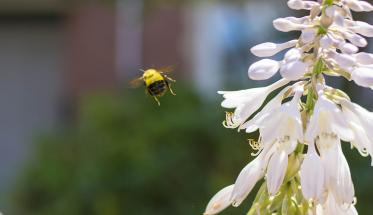This past October the U.S. Fish and Wildlife Service officially listed the rusty patched bumblebee as endangered. Robert Gegear, professor of biology and biotechnology, is studying New England-native bumblebees and hoping this will be the first and last on the list.
Through his research, which targets the neuroecology and conservation of plant-pollinator relationships, Gegear is working to increase public knowledge on the importance of native pollinator decline for ecosystem health and biodiversity. In collaboration with computer science associate professor Carolina Ruiz, biology and biotechnology associate professor Elizabeth Ryder, and a team of WPI students, he is developing new technologies that will enable citizen scientists to compile data on native pollinators and plants from the field in a user-friendly way; this will help target stressors thought to be contributing to species decline.

Rob Gegear
The team has developed a smartphone app and interactive website containing software that enables users to take a video of a bumblebee interacting with flowers, accurately identify the species, and send the information to a public database. Gegear will use the information to determine why some bumblebee species are in trouble while others are thriving, and how government agencies, conservation groups, and nature enthusiasts can keep these important species going.
“We’re integrating the fields of ecology, computer science, and bioinformatics to tackle the problem of biodiversity conservation on a large scale,” he says. “This will enable us to develop more effective conservation strategies and reintroduce key ecological features in areas where certain native species are threatened.”
Gegear recently published a paper in the journal Ecology describing how flowers visited almost exclusively by hummingbirds have evolved not to lure birds, but to discourage bees. He explains how these flowers, including those with a horizontal orientation and red or orange coloration, are harder for bees to learn and remember, and cost them extra time while trying to harvest nectar. As a result, these bees go elsewhere to seek flowers that produce more easily accessible nectar rewards.
“The answer lies in floral complexity,” he says. “Each plant has a flower made up of a unique combination of sensory and structural traits that pollinators must learn and remember in order to effectively locate nectar rewards. However, pollinators are limited in their ability to manage information on more than one unique combination at a time, making generalization a costly foraging strategy.”
Through each of these tools—as well as the continuous spread of knowledge about the ecological importance of bumblebee decline—Gegear is confident that people can do their part to prevent more native species from landing on the endangered list.
Read more about Gegear's research before checking out some tips on making your garden more bee-friendly, below.
- By Jessica Kennedy



